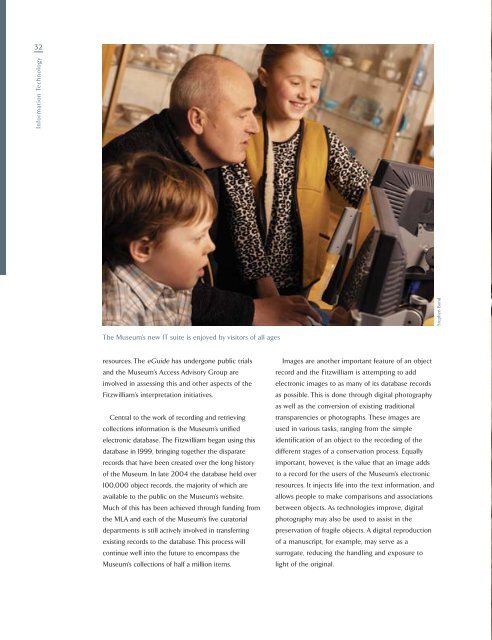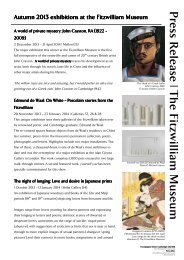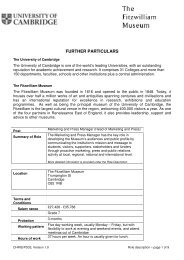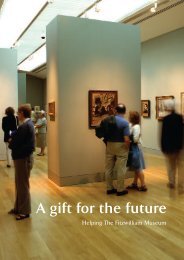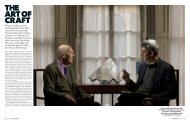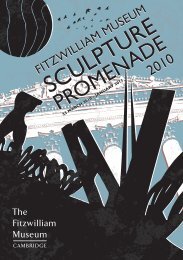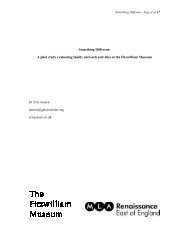The Fitzwilliam Museum - University of Cambridge
The Fitzwilliam Museum - University of Cambridge
The Fitzwilliam Museum - University of Cambridge
You also want an ePaper? Increase the reach of your titles
YUMPU automatically turns print PDFs into web optimized ePapers that Google loves.
32<br />
Information Technology<br />
<strong>The</strong> <strong>Museum</strong>’s new IT suite is enjoyed by visitors <strong>of</strong> all ages<br />
resources. <strong>The</strong> eGuide has undergone public trials<br />
and the <strong>Museum</strong>’s Access Advisory Group are<br />
involved in assessing this and other aspects <strong>of</strong> the<br />
<strong>Fitzwilliam</strong>’s interpretation initiatives.<br />
Central to the work <strong>of</strong> recording and retrieving<br />
collections information is the <strong>Museum</strong>’s unified<br />
electronic database. <strong>The</strong> <strong>Fitzwilliam</strong> began using this<br />
database in 1999, bringing together the disparate<br />
records that have been created over the long history<br />
<strong>of</strong> the <strong>Museum</strong>. In late 2004 the database held over<br />
100,000 object records, the majority <strong>of</strong> which are<br />
available to the public on the <strong>Museum</strong>’s website.<br />
Much <strong>of</strong> this has been achieved through funding from<br />
the MLA and each <strong>of</strong> the <strong>Museum</strong>’s five curatorial<br />
departments is still actively involved in transferring<br />
existing records to the database. This process will<br />
continue well into the future to encompass the<br />
<strong>Museum</strong>’s collections <strong>of</strong> half a million items.<br />
Images are another important feature <strong>of</strong> an object<br />
record and the <strong>Fitzwilliam</strong> is attempting to add<br />
electronic images to as many <strong>of</strong> its database records<br />
as possible. This is done through digital photography<br />
as well as the conversion <strong>of</strong> existing traditional<br />
transparencies or photographs. <strong>The</strong>se images are<br />
used in various tasks, ranging from the simple<br />
identification <strong>of</strong> an object to the recording <strong>of</strong> the<br />
different stages <strong>of</strong> a conservation process. Equally<br />
important, however, is the value that an image adds<br />
to a record for the users <strong>of</strong> the <strong>Museum</strong>’s electronic<br />
resources. It injects life into the text information, and<br />
allows people to make comparisons and associations<br />
between objects. As technologies improve, digital<br />
photography may also be used to assist in the<br />
preservation <strong>of</strong> fragile objects. A digital reproduction<br />
<strong>of</strong> a manuscript, for example, may serve as a<br />
surrogate, reducing the handling and exposure to<br />
light <strong>of</strong> the original.<br />
Stephen Bond


